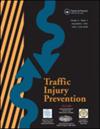Assessing the impact of cannabis use on freeway driving performance and practices: A comparative analysis with placebo and alcohol-influenced driving
IF 1.6
3区 工程技术
Q3 PUBLIC, ENVIRONMENTAL & OCCUPATIONAL HEALTH
引用次数: 0
Abstract
Objective
The objectives of this study were 1) to identify the effects cannabis has on driving performance and individual motor practices when on the freeway compared to placebo and 2) to bring context to the effects of cannabis on driving by comparing effect sizes to those of alcohol.
Methods
Data for analysis was collected from a study of fifty-three participants with a history of tetrahydrocannabinol (THC) cannabis use who completed three visits in randomized order (placebo (0% THC), 6.18% THC, and 10.5% THC). Data for the alcohol analysis was from a subset of eighteen of these participants with a history of recent alcohol use that completed a fourth alcohol visit that targeted a .05 g/210L breath alcohol content (BrAC) during the drive. Comparisons were made using an analysis of variance approach with the SAS General Linear Models Procedure. Cohen’s d effect sizes were calculated for the cannabis and alcohol conditions relative to placebo for both the full sample and alcohol subset.
Results
Standard deviation of lane position (SDLP) for cannabis significantly increased compared to placebo and the effect size was comparable to that of alcohol at .05 BrAC. Lane departures for cannabis significantly increased relative to placebo as did the time out of the lane. Cannabis use resulted in an increased amount of time at 10% or more below the speed limit for the 6.18% THC condition. Relative to alcohol, cannabis produced more time at slower speeds and less time at speeds more than 10% above the speed limit.
Conclusions
Multiple factors of lateral and longitudinal vehicle control on the freeway showed statistical significance. Drivers under the influence of cannabis exhibited higher rates of driving errors but also showed more cautious behaviors such as generally lower speeds on the freeway. Compared with alcohol, effect sizes varied. For longitudinal control, there were larger effect sizes for alcohol with speed effects in opposite directions, but relatively equivalent effect sizes for lateral control and driving errors associated with lane keeping.
评估吸食大麻对高速公路驾驶表现和实践的影响:与安慰剂和酒精影响驾驶的比较分析。
目标:本研究的目的是:1)与安慰剂相比,确定大麻在高速公路上对驾驶表现和个人运动习惯的影响;2)通过比较大麻与酒精的影响大小,了解大麻对驾驶影响的背景:用于分析的数据收集自一项研究,研究对象为 53 名有四氢大麻酚(THC)大麻使用史的参与者,他们按照随机顺序完成了三次访问(安慰剂(0% THC)、6.18% THC 和 10.5% THC)。用于酒精分析的数据来自其中 18 名近期有饮酒史的参与者的子集,这些参与者完成了第四次酒精检测,检测目标是驾驶过程中呼气酒精含量(BrAC)达到 0.05 克/210 升。比较采用了 SAS 一般线性模型程序的方差分析方法。计算了全样本和酒精子集的大麻和酒精条件相对于安慰剂的 Cohen'd 效果大小:结果:与安慰剂相比,大麻的车道位置标准偏差(SDLP)显著增加,在 0.05 BrAC 时,其效应大小与酒精相当。与安慰剂相比,吸食大麻的车道偏离率明显增加,离开车道的时间也明显增加。在 THC 含量为 6.18% 的情况下,吸食大麻导致低于限速 10% 或以上的时间增加。与酒精相比,吸食大麻会导致更多的低速行驶时间和更少的超速 10%以上的行驶时间:结论:高速公路上车辆横向和纵向控制的多个因素在统计学上都有显著意义。受大麻影响的驾驶者表现出更高的驾驶错误率,但也表现出更谨慎的行为,如在高速公路上普遍降低车速。与酒精相比,效果大小各不相同。在纵向控制方面,酒精对速度的影响在相反方向的影响更大,但对横向控制和与车道保持相关的驾驶错误的影响相对相当。
本文章由计算机程序翻译,如有差异,请以英文原文为准。
求助全文
约1分钟内获得全文
求助全文
来源期刊

Traffic Injury Prevention
PUBLIC, ENVIRONMENTAL & OCCUPATIONAL HEALTH-
CiteScore
3.60
自引率
10.00%
发文量
137
审稿时长
3 months
期刊介绍:
The purpose of Traffic Injury Prevention is to bridge the disciplines of medicine, engineering, public health and traffic safety in order to foster the science of traffic injury prevention. The archival journal focuses on research, interventions and evaluations within the areas of traffic safety, crash causation, injury prevention and treatment.
General topics within the journal''s scope are driver behavior, road infrastructure, emerging crash avoidance technologies, crash and injury epidemiology, alcohol and drugs, impact injury biomechanics, vehicle crashworthiness, occupant restraints, pedestrian safety, evaluation of interventions, economic consequences and emergency and clinical care with specific application to traffic injury prevention. The journal includes full length papers, review articles, case studies, brief technical notes and commentaries.
 求助内容:
求助内容: 应助结果提醒方式:
应助结果提醒方式:


